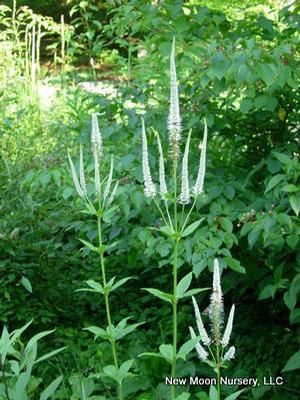Printed at http://www.newmoonnursery.com/index.cfm/
Veronicastrum virginicum
Culver root
Native to North America
FIRST IMPRESSIONS: Veronicastrum virginicum is a tall robust perennial wildflower with attractive whorled leaves. In early and mid-summer plants are crowned by spiky racemes densely packed with tiny tubular white florets. The inflorescences branch several times giving the appearance of a dramatic candelabra. Plants thrive in open woods and wet meadows or prairies.
HABITAT & HARDINESS: Veronicastrum virginicum occurs in Manitoba, Ontario and Nova Scotia and from Maine to North Dakota and south to the Florida panhandle and east Texas. Distribution is greatest in states bordering the Great Lakes.
Plants are indigenous to moist to mesic Blackland prairies, sand prairies, wet meadows, savannas, openings and borders of woods, thickets and banks of rivers, creeks and ditches.
This species is hardy from USDA Zones 3-8.
PLANT DESCRIPTION: Veronicastrum virginicum is an upright perennial wildflower. Stems are round and smooth and are unbranched except near the tip.
Leaves are whorled along the stems in groups of 3-7. Each toothed leaf is about 6” long and 1.5” across. Blades are oval or lance shaped and can be sessile or have short petioles.
For about a month in summer, stems terminate in slender spike-like racemes. Each raceme is about 8” long and is densely packed with ¼ tubular white or pale blue florets with exerted stamens. The racemes branch into a lovely upright arrangement of elegant branched spires.
Florets mature into capsules full of small brown seed.
Plants are 4-8’ tall with 2-4’ spread. They originate from a sturdy taproot and can expand into larger clumps from underground rhizomes.
CULTURAL & MAINTENANCE NEEDS: Veronicastrum virginicum prefers sunny wet sites or gardens with moist rich acidic soil.
Plants tolerate light shade but will flop is shade is too dense. This species will adapt to sandy, loamy or clay soils and brief periods of drought.
Culver’s Root is fairly pest resistant but may have some issues with root borers. Foliage is unpalatable to deer and other herbivores.
Plants can be slow to establish in the garden - not reaching their potential for three or so years.
LANDSCAPE USES: In bloom, Veronicastrum virginicum is a striking vertical Accent for a Wildlife Garden or Meadow. Plants are also useful Butterfly Nectar Plants, Cut Flowers or components of Grouping or Mass Plantings. This wildflower has Showy Blooms and handsome foliage. It is an asset to Cottage Gardens, Low Maintenance Plantings, Rain Gardens or Perennial Borders.
COMPANION & UNDERSTUDY PLANTS: Try pairing Veronicastrum virginicum with Andropogon gerardii, Asclepias incarnata, Aster puniceus, Eupatoriium fistulosum, Rudbecia maxima, Panicum virgatum or Vernonia noveboracensis.
Since Verbena hastata has comparable cultural needs and similar candelabra shaped inflorescences, it could serve as a substitute in some situations.
TRIVIA: Flowers provide pollen and nectar to many species of long-tongued and short-tongued bees, beneficial wasps, Syrphid flies, butterflies and moths.
The generic name is from “Veronica”, the Latin for the speedwell plant combined with “astrum” which means having a resemblance. So Veronicastrum spp. somewhat resembles speedwell. This species was formerly known as Leptandra virginica and as Veronica virginica.
Veronicastrum virginicum was recently reclassified from the Scrophulariaceae (Figwort Family) to the Plantaginaceae (Plantain Family).
The common name is for an early 18th century herbalist or physician, Dr. Culver (or Coulvert), who promoted the use of the root as a laxative.
Height:
4-8 ftSpread:
2-3 ftSpacing:
2-3 ftUSDA Hardiness Zone:
3-8Bloom Color:
WhiteVeronicastrum virginicum Characteristics
Attracts Wildlife
- Butterflies
- Pollinators
Attributes
- Drought Tolerant
- Rain Garden
- Dried Flower
- Cut Flower
- Clay Soil
- Naturalizing
- Bog
- Long Blooming
- East-Coast Native
Exposure
- Full Sun to Partial Shade
Flowering Months
- August
- July
Foliage Color
- Green
Growth Rate
- Medium
Season of Interest (Foliage)
- Summer
- Spring
Soil Moisture Preference
- Moist to Wet
Interesting Notes:
For more information on this plant, visit the USDA PLANTS Database: http://plants.usda.gov/java/profile?symbol=VEVI4

